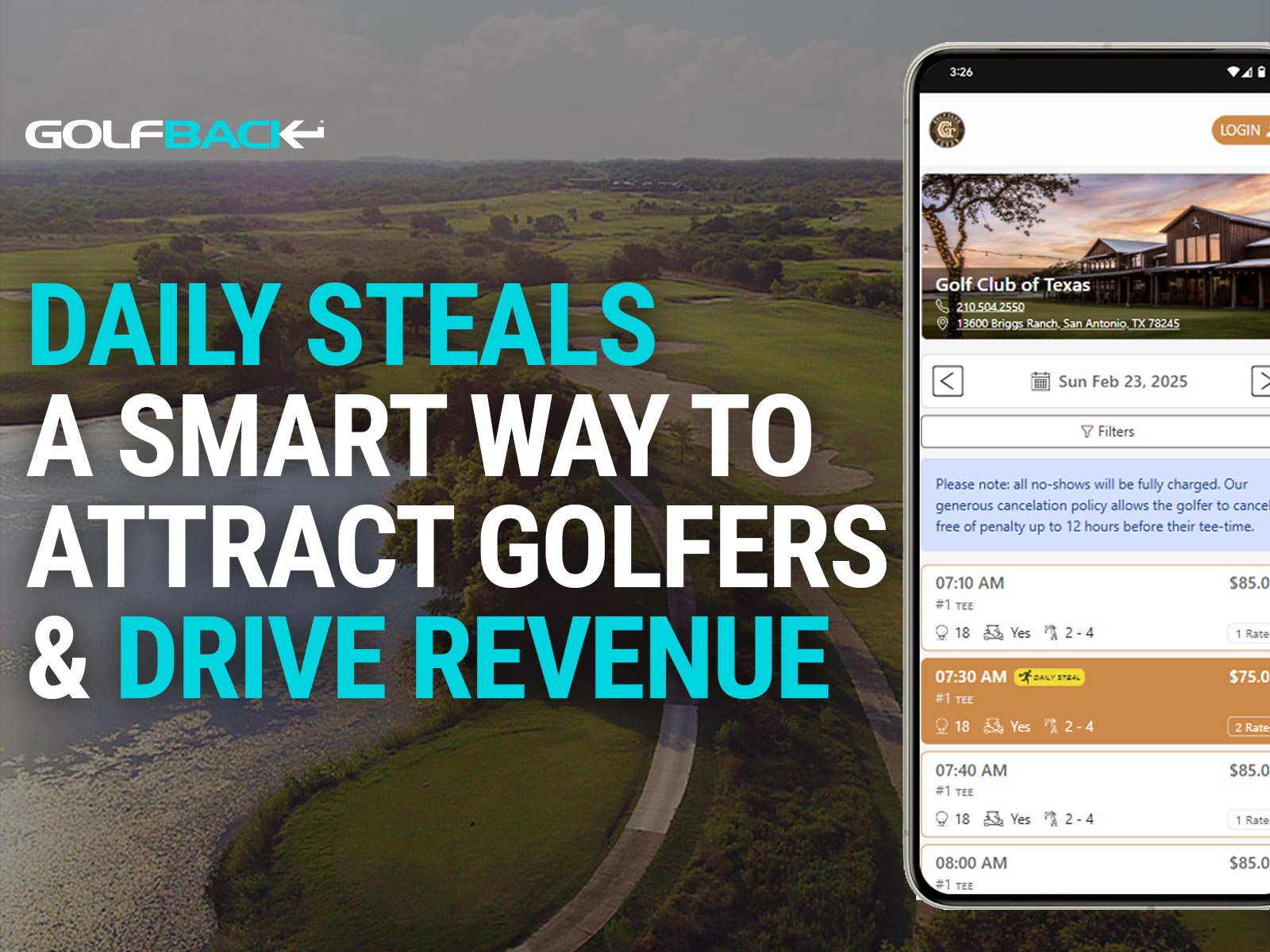What is Revenue Optimization in Golf?
Revenue optimization in golf refers to the strategic process of maximizing income and financial performance for golf courses and related businesses.
This involves employing various strategies and tactics to generate the highest possible revenue while maintaining a balance between customer satisfaction and operational efficiency.
Revenue optimization encompasses a range of activities, including dynamic pricing, effective tee time management, strategic marketing, leveraging data analytics, and offering targeted promotions.
By analyzing demand patterns, customer preferences, and market trends, golf courses can make informed decisions to ensure that each tee time is priced appropriately, driving higher bookings and revenue without compromising the overall customer experience.
The Pillars of Revenue Optimization
💰 Pricing Strategies – Jump to section →
🛒 Inventory Management – Jump to section →
🪣 Customer Segmentation – Jump to section →
📊 Data Analytics – Jump to section →
Pricing Strategies - How to set the right price for your golf course
Analyze Your Costs
Start by understanding your fixed and variable costs associated with running the golf course. This includes maintenance, staff salaries, utilities, and any other operational expenses. Knowing your costs will help you establish a baseline for pricing that ensures you cover your expenses.
I have heard “we charge $35 because that is what we feel the course is worth” – Pricing by feel and historical rates can easily get an operator in trouble. It’s best to know the baseline cost for every round that hits the course and start from there.
Study the Market
Research your competitors and neighboring golf courses to understand how they are pricing their tee times. Consider their amenities, location, and reputation to identify where your golf course fits in the market landscape.
Understand the different types of customers your golf course attracts. There might be golfers looking for budget-friendly options, those seeking premium experiences, and everything in between. Tailor your pricing to cater to these segments.
Understand Demand
Analyze historical data to identify peak and off-peak times. Consider seasonal variations, weekends, holidays, and weather conditions that impact demand. Dynamic pricing software can help you adapt prices based on real-time demand fluctuations.
Monitor and Adjust
Regularly monitor the effectiveness of your pricing strategy. Analyze booking trends, revenue, and customer feedback. Be prepared to adjust your prices based on the insights you gather.
Listen to Customer Feedback
Engage with your customers and gather feedback on your pricing strategy. Understanding their perceptions and preferences can guide your pricing decisions.
Leverage Technology
Invest in golf management software that includes pricing optimization tools. These platforms use data analytics to help you make informed pricing decisions.
Remember that finding the right price is an ongoing process. It requires a balance between generating revenue and providing value to your customers. Continuously adapt your pricing strategy based on changing market dynamics, customer behavior, and business goals to ensure your golf course remains competitive and profitable.
Inventory Management - How to create an effective plan?
Once you have your baseline pricing set, it’s time to put together a plan of effectively managing the available tee times for sale at your golf course. Effective Inventory Management or “Tee Sheet Management” of your golf course involves getting all your staff on board, strategic planning and guidelines, and communicating with the customer.
Below are a few tee sheet management tactics to deploy.
Pair twosomes on your tee sheet
If a customer calls your first question should be how many players do you have? If a customer wants something around 10:00 and you have a twosome already booked at 10:15 you should do everything in your power to pair that twosome leaving more availability for foursomes.
The first question asked of a customer on the phone should always be “how many players do you have?”.
Stop including tax in your pricing
At $50/round you are eating at least $3 per round of sales tax. If you are doing 25,000 rounds, that’s an easy increase of $75k to the bottom line.
Create a Double Tee Setup
Deploying a double tee setup can create more inventory during a premium window and should be utilized when applicable. We have seen courses skyrocket their revenue utilizing a double-tee setup.
Open your tee sheet earlier if full
If you normally start your tee times at 7:30 during the week but are full at 7:30 until 8:00 open up times prior to 7:30. This added revenue adds up over the course of a year.
Add Squeeze tee times
Add at least one every two hours. If you are full for a day-part squeeze in a time and we can sell it at a premium.
9-Hole Back Nine Starts
Use 9-hole rounds early in the morning off the #10 tee, after a shotgun tournament off of the #10 tee, and in the late afternoon/evenings. $100 per day in revenue from these times would produce $25,000 in annual revenue or more!
Do NOT sell 9-hole times in premium windows.
Communicate, then communicate again
Inform customers of your booking policies prior to booking a tee time. If they are aware that you might move their tee time by 10 minutes, then they are less likely to be upset. If you do pair a twosome or a single golfer and move their tee time, let them know of the switch.
Drive golfers directly to your most profitable channels
Make sure that every tee time booked into a premium window costs you very little on the back end. Analyze every relationship with third-party marketplaces and wholesale resellers as you may find that they are only sending you tee times when you don’t need outside help to fill the tee sheet.
Customer Segmentation - Tailoring your approach to different customer groups
Customer segmentation is a crucial strategy that involves categorizing your customer base into distinct groups based on shared characteristics, preferences, behaviors, and needs. By dividing your customers into segments, you can tailor your marketing efforts, offerings, and services to better meet the unique requirements of each group. Here’s how customer segmentation can be applied effectively in the golf industry:
Demographic Segmentation
Divide your customers based on demographic factors such as age, gender, income level, and location. For instance, you might create segments for senior golfers, families, young professionals, or tourists visiting the area.
Behavioral Segmentation
Segment customers based on their behavior and interactions with your golf course. This could include factors like how frequently they play, their preferred tee times, whether they book in advance or on short notice, and their spending habits.
Psychographic Segmentation
Skill Level Segmentation
Segment golfers based on their skill levels, ranging from beginners to advanced players. This can help you tailor instructional programs, course difficulty, and tee time availability to cater to different skill levels.
Time Preference Segmentation
Categorize golfers based on their preferred tee times. Some may enjoy early morning rounds, while others might prefer twilight hours. Adjust your pricing and availability to match these preferences.
Competitive Golfer Segmentation
Segment golfers who are interested in competitive play, tournaments, and leagues. Tailor promotions and events to cater to their competitive spirit and desire for challenging play.
Casual Golfer Segmentation
Create segments for casual golfers who prioritize a relaxed and enjoyable experience. Offer packages that focus on leisurely play, socializing, and enjoying the scenery.
Seasonal Golfer Segmentation
Divide golfers based on their seasonal preferences. Some may be regulars during certain times of the year, while others might only play during specific seasons. Customize your offerings accordingly.
Family-Focused Segmentation
Segment golfers who play with their families. Offer family-friendly tee times, junior golf programs, and amenities that cater to parents and children.
Promotions and Offers
Tailor promotions, discounts, and packages to each segment’s preferences and needs. For example, offer discounted rates for senior golfers during weekdays or family-friendly packages during weekends.
Communication and Marketing
Craft marketing messages and campaigns that resonate with each segment’s characteristics. Use the right tone, imagery, and messaging to connect with their interests and aspirations.
Continuous Refinement
Regularly review and update your segments based on changing trends, customer feedback, and market dynamics. Adapt your strategies as you gather more data and insights.
Customer segmentation empowers golf courses to offer a personalized experience, which can enhance customer satisfaction and loyalty. By understanding your customers on a deeper level and tailoring your offerings to their unique needs, you can create a more meaningful connection and drive growth for your golf business.
Data Analysis - Leverage the Data to Make Informed Decisions
Data analysis plays a crucial role in achieving revenue optimization in the golf industry. By leveraging data-driven insights, golf courses can make informed decisions to maximize revenue, enhance customer experiences, and streamline operations. Here’s how data analysis can be utilized for revenue optimization in golf:
Demand Analysis
Collect and analyze historical booking data to identify patterns in tee time demand. Look for trends related to peak and off-peak times, busy days, and seasonal variations. This analysis helps you understand when and where demand is highest, enabling you to adjust pricing and promotions accordingly.
Dynamic Pricing Strategies
Utilize data analytics to implement dynamic pricing strategies. Monitor real-time demand fluctuations and adjust tee time rates based on factors such as time of day, weather conditions, and booking trends. Data-driven dynamic pricing ensures that you capture maximum revenue during high-demand periods.
Customer Segmentation
Segment your customer base based on factors like demographics, preferences, and booking behaviors. Analyze this data to tailor offerings and promotions that resonate with different customer segments. For instance, offer family packages for weekends or twilight rates for budget-conscious golfers.
Utilization Trends
Examine data on tee time utilization rates to identify trends in course occupancy. Are there specific times or days when the course is underutilized? Use this information to create targeted promotions or packages to fill those gaps.
Feedback Analysis
Collect and analyze customer feedback, both positive and negative. This data provides insights into customer satisfaction, preferences, and pain points. Addressing feedback can enhance customer experience and improve repeat business.
Booking Platform Insights
If you have an online booking platform, analyze user behavior on your website. Which tee times are most frequently booked? Which pages do users spend the most time on? This information helps optimize your website’s user experience and tailor your offerings.
Seasonal Adjustments
Analyze data across different seasons to identify trends unique to each time of year. Adjust pricing, promotions, and offerings based on these seasonal variations to ensure you’re capitalizing on demand throughout the year.
Long-Term Planning
Use historical data to forecast future demand and revenue. This aids in long-term planning, including budgeting, staffing, and marketing efforts.
Experimentation and Iteration
Use A/B testing or pilot programs to experiment with different pricing strategies or promotions. Analyze the results to determine what resonates best with your customer base and drives the highest revenue.
Incorporating data analysis into revenue optimization strategies empowers golf courses to make data-driven decisions. By understanding customer behavior, demand patterns, and market dynamics, you can tailor your pricing, promotions, and operations to maximize revenue while delivering exceptional experiences to golfers.
The Role of Marketing in Revenue Optimization
Maximizing Tee Time Bookings Through Strategic Communication & Marketing
By integrating these tactics, golf courses can drive more direct bookings, improve customer satisfaction, and maintain a consistently strong demand for tee times.
Clear Availability Information
Make sure your website, social media platforms, and any booking channels clearly display tee time availability. Provide details about peak and off-peak times, special events, and promotions.
Real-Time Updates
Utilize tee time management software to ensure that your online booking platforms reflect real-time availability. Nothing frustrates potential customers more than outdated or incorrect information.
Email Campaigns
Create email campaigns to inform your customer base about upcoming events, promotions, and tee time availability. Segment your email list to target different customer segments with relevant offers.
Social Media Engagement
Use your social media channels to showcase different tee time options and highlight customer experiences at various times of the day. Engage with your audience through polls and posts that ask about their preferred tee times.
Seasonal Promotions
Launch seasonal promotions during slower periods to stimulate demand. For example, offer discounted rates for early morning or twilight tee times during off-peak seasons.
Last-Minute Deals
Send out last-minute deals and offers to encourage spontaneous bookings during times when demand is lower than usual.
User-Friendly Booking Process
Ensure that your online booking process is user-friendly and intuitive. Potential customers should be able to easily select tee times, view prices, and complete bookings without any obstacles.
Mobile Optimization
Since many golfers use smartphones to access information and make bookings, make sure your website and booking platform are mobile-friendly for seamless browsing and bookings on the go.
Customer Reviews and Testimonials
Showcase positive customer reviews and testimonials that highlight different tee time experiences. This can help potential customers make informed decisions about their preferred tee times.
Incorporating data analysis into revenue optimization strategies empowers golf courses to make data-driven decisions. By understanding customer behavior, demand patterns, and market dynamics, you can tailor your pricing, promotions, and operations to maximize revenue while delivering exceptional experiences to golfers.
In-Depth Blog Content
Create blog posts that discuss the advantages and experiences of playing at different times of the day. These posts can help golfers understand the benefits of early morning rounds, mid-day play, and twilight golf.
Booking Reminders
Send booking reminders to customers who have made reservations, encouraging them to make the most of their chosen tee time.
Turning Communication into a Competitive Advantage
Successful revenue optimization isn’t just about pricing, it’s about how well you communicate value to your golfers. A strategic approach to marketing and communication ensures that every available tee time is seen, understood, and booked by the right golfer at the right time.
By leveraging multiple channels, website updates, email campaigns, social media, and real-time availability tools, you create a seamless booking experience that eliminates friction and builds trust. Engaged golfers are more likely to book direct, return often, and become long-term advocates for your course.
When golf courses prioritize clear, proactive communication and thoughtful marketing strategies, they aren’t just filling tee times, they’re strengthening customer relationships, improving loyalty, and setting their course apart from the competition. The courses that thrive aren’t just the ones with the best rates, they’re the ones that tell the best story, engage their audience, and make booking a round of golf as simple and rewarding as possible.
Real World Examples of Revenue Optimization

Daily Steals: A Smart Way to Attract Golfers and Drive Revenue

Navigating the Challenges of Revenue Optimization in Golf
Revenue optimization has become a powerful tool for golf courses looking to maximize profitability and improve tee sheet utilization. However, like any strategy, it comes with considerations that require careful planning and execution. When done correctly, revenue optimization, including dynamic pricing, enhances both course profitability and golfer satisfaction. Here are key factors to keep in mind to ensure a successful and golfer-friendly approach to pricing strategies.
Educating Customers About Pricing Adjustments
Golfers appreciate transparency when it comes to pricing. Clearly communicating why rates fluctuate, such as demand, availability, and course conditions, helps manage expectations and ensures players see pricing as fair rather than unpredictable.
Using Technology as a Tool, Not a Substitute for Human Oversight
While automation simplifies pricing adjustments, human oversight remains essential to ensure that pricing changes make sense. A well-balanced approach blends technology with expert judgment, preventing errors that could impact golfer satisfaction.
Staying Competitive Without Engaging in Price Wars
It’s natural to monitor competitor pricing, but the goal of revenue optimization is to maximize value, not to undercut other courses. Golfers choose courses based on experience, service, and value, not just price, so keeping rates aligned with your brand and course reputation is key.
Ensuring Data Accuracy for Smarter Pricing Decisions
A successful revenue strategy is only as good as the data behind it. Using reliable, real-time booking trends, weather forecasts, and historical performance helps ensure that pricing decisions are based on accurate insights, not guesswork.
Maintaining Customer Loyalty While Adapting to Market Demand
When implemented correctly, dynamic pricing can strengthen customer relationships rather than weaken them. Offering loyalty perks, exclusive tee time access, and personalized offers help ensure that frequent golfers feel valued and not priced out.
Managing External Factors That Influence Demand
Unexpected weather shifts, local events, and seasonal trends all impact demand. Revenue optimization tools should be flexible enough to adjust pricing in real-time while still prioritizing the golfer experience.
Ethical and Transparent Pricing Practices
Golf courses should use revenue optimization to maximize value for golfers, not just to increase short-term revenue. Providing early-bird discounts, value-added perks, and transparent pricing creates a positive perception of dynamic pricing as a benefit, not a cost.
Making Implementation Simple and Effective
Adopting revenue optimization strategies should enhance, not complicate, operations. By using intuitive tools like GolfBack’s Dynamic Pricing Slider, courses can adjust pricing quickly and easily without burdening staff or creating operational confusion.
Aligning Pricing with Brand & Course Experience
A well-thought-out pricing strategy should reflect the course’s identity and target audience. Pricing adjustments should feel strategic and intentional, reinforcing the quality and reputation of the golf experience.
Turning Customer Feedback into a Strength
Dynamic pricing doesn’t have to result in negative feedback if it’s implemented with transparency and fairness. Listening to golfer input and explaining why certain tee times cost more or less helps reinforce trust.
Training Staff to Confidently Communicate Pricing
Equipping staff with the right talking points ensures they can explain pricing adjustments with confidence. When employees understand how pricing works, they can address customer concerns effectively and highlight the value of dynamic pricing.
Ensuring Balanced Tee Sheet Utilization
A strategic pricing model optimizes tee sheet occupancy without overloading peak times or leaving gaps in off-peak hours. Smart pricing ensures steady play throughout the day, leading to better course flow and customer satisfaction.
Ensuring Balanced Tee Sheet Utilization
When offering dynamic pricing to the public, it’s important to ensure that membership programs still feel like a valuable investment. Exclusive perks, priority tee times, and added benefits can help maintain strong membership retention while implementing revenue-boosting pricing strategies.
The key to successful revenue optimization is striking a balance between profitability, customer experience, and strategic pricing adjustments. By focusing on transparency, fairness, and long-term golfer relationships, courses can increase revenue without alienating customers.
Key Takeaways and Actionable Tips to develop a Revenue Optimization Strategy at your Golf Facility.
1. Establish a Strong Pricing Strategy
Key Takeaways:
- Pricing should be data-driven, not based on gut feeling or outdated practices.
- A balance between price and value ensures golfers feel they are getting a fair deal.
- Prices should fluctuate based on demand, availability, and external factors like weather and seasonality.
- Transparency is key, clearly communicate why prices change to avoid negative perceptions.
Strategy for Success:
- Understand Your Costs: Set a baseline by knowing your fixed and variable costs per round.
- Analyze Market & Competitor Pricing: Position your course competitively while ensuring profitability.
- Segment Your Golfers: Create different pricing structures for casual, competitive, early morning, and twilight players.
- Use Demand Based Pricing: Charge more during peak hours and offer incentives for lower-demand tee times.
- Leverage Data & Adjust Regularly: Track trends, adjust pricing as needed, and review performance monthly.
2. Optimize Inventory & Tee Sheet Management
Key Takeaways:
- A well-structured tee sheet ensures maximized revenue and efficiency.
- Small operational changes can increase inventory without affecting golfer experience.
- Underutilized tee times are a lost revenue opportunity.
Strategy for Success:
- Pair Twosomes Whenever Possible: Fill gaps to maximize foursome play.
- Open Earlier If Demand Justifies It: Don’t let a full morning tee sheet limit revenue potential.
- Implement a Double Tee Setup: Utilize both nines strategically during premium windows.
- Introduce 9-Hole Back Nine Starts: Offer flexible, off-peak 9-hole rounds.
- Add Squeeze Tee Times: Strategically place additional times when demand allows.
3. Leverage Customer Segmentation for Smarter Marketing
Key Takeaways:
- Not all golfers are the same: Customizing your marketing and pricing improves engagement.
- Segmenting your audience allows you to send targeted promotions and increase loyalty.
- Personalized offers make golfers feel valued and appreciated.
Strategy for Success:
- Use Demographic & Behavioral Segmentation: Offer different promotions for seniors, families, and competitive players.
- Leverage Tee Time Preferences: Send targeted emails to morning golfers about early-bird discounts.
- Recognize Repeat Players: Offer rewards or exclusive pricing for frequent visitors.
- Communicate via the Right Channels: Engage golfers through email, SMS, and social media based on their preferences.
4. Use Data & Analytics to Drive Decisions
Key Takeaways:
- Data eliminates guesswork—use real numbers to make informed decisions.
- Tracking demand trends, no-shows, and booking behaviors allows for proactive adjustments.
- Testing different strategies helps identify what resonates best with your audience.
Strategy for Success:
- Analyze Booking Data: Identify peak vs. off-peak trends and adjust pricing accordingly.
- Track Competitor Pricing: Stay competitive without devaluing your brand.
- Use A/B Testing for Promotions: Test different discounts and track golfer response.
- Monitor Long-Term Trends: Use historical data to forecast demand and improve future pricing strategies.
5. Strengthen Marketing & Communication
Key Takeaways:
- Clear communication prevents misunderstandings.
- A well-crafted marketing strategy increases tee time bookings and brand loyalty.
- Offering value beyond pricing like exclusive perks and promotions keeps golfers engaged.
Strategy for Success:
- Be Transparent About Pricing Changes: Educate golfers on how pricing is determined.
- Use social media & Email Marketing: Promote available tee times, special offers, and last-minute deals.
- Highlight Seasonal Promotions: Attract golfers with time-sensitive incentives.
- Create a User-Friendly Booking Experience: Make online tee time booking seamless and hassle-free.
- Engage with Customers: Respond to feedback and build strong relationships with your players.
6. Manage External Factors & Maintain Customer Trust
Key Takeaways:
- Weather, economic shifts, and unforeseen events affect demand.
- Trust and loyalty are built through consistency and fairness in pricing and policies.
- A customer-first mindset ensures long-term success, not just short-term gains.
Strategy for Success:
- Have a Contingency Plan: Prepare for weather disruptions and adjust pricing accordingly.
- Maintain Ethical Pricing Practices: Avoid extreme price hikes during peak periods.
- Reward Customer Loyalty: Offer exclusive benefits for long-term players.
- Ensure Staff Training: Educate staff on revenue optimization strategies and customer service.
Final Thoughts: Revenue Optimization That Works for Everyone
Revenue optimization isn’t just about raising prices, it’s about smarter pricing, better utilization, and enhanced golfer satisfaction. A well-executed strategy allows courses to maximize profitability while maintaining fair and transparent pricing.
By analyzing data, optimizing inventory, segmenting customers, and refining pricing, golf facilities can enhance revenue without sacrificing golfer experience.



